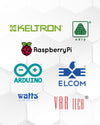
Top Tips for Maintaining Connectors in Industrial Environments
In industrial environments where dust, vibration, moisture, chemicals, and temperature extremes are common, electrical connectors face constant threats. A single corroded or loose connector can bring an entire production line to a halt, leading to unexpected downtime, data loss, or even safety hazards. That’s why proper maintenance of connectors is critical for ensuring operational continuity, electrical reliability, and system safety in industrial systems.
This guide explores essential tips and best practices for maintaining connectors in harsh industrial environments, including cleaning procedures, inspection routines, selection of ruggedized connectors, and protective measures that can dramatically extend connector life.
The Role of Connectors in Industrial Systems
Connectors are essential for joining wires, cables, sensors, and control modules in industrial settings. They facilitate power transmission, signal integrity, and equipment interoperability. From PLCs (Programmable Logic Controllers) and servo drives to fieldbus interfaces and motor control systems, reliable connectors form the backbone of electrical communication.
However, unlike controlled environments like laboratories or clean rooms, industrial sites present unique challenges, oil mist on production lines, metal dust in machine shops, humidity in processing plants, and mechanical shocks in automation systems.
Maintaining connector performance in these environments requires a proactive approach.
1. Regular Inspection and Cleaning
One of the simplest yet most effective ways to prevent connector failure is routine visual inspection and cleaning. Dirt, dust, and residue build-up on contact surfaces can increase electrical resistance, leading to intermittent connections or total failure.
How to clean connectors properly:
-
Disconnect power before inspection or cleaning.
-
Use a soft brush or lint-free cloth to remove loose dust.
-
Apply isopropyl alcohol (IPA) on a cotton swab or foam tip to clean pins or sockets.
-
Avoid abrasive tools that might damage plating or contact surfaces.
-
Let the connector dry completely before reconnecting.
Schedule cleaning based on the operating environment. Monthly for dusty or high-vibration areas, quarterly for cleaner zones.
2. Use the Right Connector for the Environment
Prevention starts with proper connector selection. Using a consumer-grade connector in a heavy-duty industrial setting is asking for trouble. Look for connectors with industrial-grade specs:
-
IP65 to IP68 ratings: Protects against dust and water ingress.
-
EMI/RFI shielding: Prevents electrical noise interference.
-
UV- and oil-resistant housings: Crucial for outdoor or petrochemical applications.
-
Locking mechanisms: Avoids accidental disconnection from vibration or human error.
Ruggedized industrial connectors like M12 circular connectors, heavy-duty DIN connectors, and IP-rated terminal blocks are designed to withstand extreme conditions.
Explore industrial-grade connectors at Tomson Electronics that offer these features.
3. Protect Against Moisture and Corrosion
Moisture and condensation are major enemies of metal contacts. Over time, they cause oxidation or corrosion that impairs conductivity and leads to failure.
Preventive measures:
-
Use gel-sealed or O-ring-equipped connectors.
-
Apply dielectric grease on metal contacts to displace moisture.
-
Install cable glands or sealed enclosures around connectors in washdown areas.
-
For outdoor installations, ensure connectors face downward or are enclosed in weatherproof boxes.
In marine, chemical, or food processing facilities, use corrosion-resistant materials like stainless steel or gold-plated contacts.
4. Monitor for Vibration and Mechanical Stress
In automation and robotics, connectors are frequently exposed to vibration, movement, and mechanical shock. Over time, these forces can loosen connections or crack insulation.
How to address mechanical stress:
-
Use strain relief boots or cable clamps to prevent wire pull-out.
-
Opt for connectors with bayonet or screw locks to keep connections secure.
-
Position connectors away from moving parts when possible.
-
Secure cables with flexible conduits or drag chains in high-motion areas.
Additionally, torsion-tolerant cable assemblies can help preserve signal integrity in rotating or oscillating machinery.
5. Inspect for Heat and Electrical Overload
Excessive heat can degrade insulation, warp connector housings, and oxidize contact surfaces. Repeated electrical overloads also stress connector joints and may melt surrounding plastic.
Key practices:
-
Choose connectors rated for both current and voltage above your maximum expected load.
-
Avoid over-tightening terminals or connectors, which may deform contacts.
-
Look for discoloration, melting, or smell of burnt plastic during inspections.
-
Ensure cables are properly sized to prevent overheating near the connector.
Thermal imaging cameras can help detect overheating spots before failure occurs.
6. Standardize Maintenance Procedures
Create a formalized maintenance checklist for all connectors across your facility. This ensures consistency and allows early detection of potential issues.
A typical checklist might include:
-
Visual inspection for damage, discoloration, or corrosion
-
Cleaning cycle based on connector type and environment
-
Torque check for screw-type connectors
-
Contact resistance measurement using a multimeter
-
Record of last service and parts replaced
Train maintenance staff to recognize signs of connector degradation and know when to escalate for replacement or isolation.
7. Replace Worn or Damaged Connectors Promptly
Once a connector begins to show signs of wear, intermittent operation, or discoloration, it’s best to replace it early. The cost of a new connector is minor compared to the downtime from a faulty one in a critical control loop or safety system.
Keep an inventory of common connector types and use consistent part numbers across installations. This simplifies troubleshooting and speeds up replacement.
Visit Tomson Electronics for a variety of connectors and maintenance accessories like contact grease, heat shrink sleeves, and cable glands.
Bonus Tip: Label and Document All Connections
In large industrial systems, proper labeling of connectors and cable harnesses is vital. Use heat shrink labels, color coding, or panel engravings to identify connector functions.
Keep updated wiring diagrams, connector datasheets, and part lists available for maintenance teams. This not only speeds up fault tracing but also ensures safe reassembly after disconnection.
Final Thoughts
Maintaining connectors in industrial environments is more than just good practice, it’s essential for system uptime, safety, and long-term reliability. As factories and plants become more connected and automated, the humble connector plays an increasingly important role in maintaining signal integrity and power delivery.
By following these best practices - routine cleaning, proper selection, moisture protection, stress mitigation, heat monitoring, standardized maintenance, and timely replacement, you can significantly extend the service life of connectors and reduce unexpected downtime.
For reliable, rugged connectors and maintenance tools, check out Tomson Electronics, where you’ll find everything from IP-rated terminal blocks to panel-mount circular connectors designed for industrial-grade performance.
Need help selecting the right connector for your environment? We’re happy to help you choose the best fit based on current, environment, and application type.



